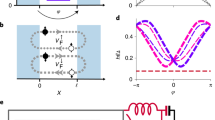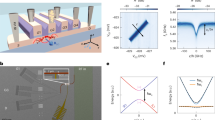Abstract
Andreev spin qubits have recently emerged as an alternative qubit platform with realizations in semiconductor–superconductor hybrid nanowires. In these qubits, the spin degree of freedom of a quasiparticle trapped in a Josephson junction is intrinsically spin–orbit coupled to the supercurrent across the junction. This interaction has previously been used to perform spin readout, but it has also been predicted to facilitate inductive multi-qubit coupling. Here we demonstrate a strong supercurrent-mediated longitudinal coupling between two distant Andreev spin qubits. We show that it is both gate- and flux-tunable into the strong coupling regime and, furthermore, that magnetic flux can be used to switch off the coupling in situ. Our results demonstrate that integrating microscopic spin states into a superconducting qubit architecture can combine the advantages of both semiconductors and superconducting circuits and pave the way to fast two-qubit gates between distant spins.
This is a preview of subscription content, access via your institution
Access options
Access Nature and 54 other Nature Portfolio journals
Get Nature+, our best-value online-access subscription
$29.99 / 30 days
cancel any time
Subscribe to this journal
Receive 12 print issues and online access
$209.00 per year
only $17.42 per issue
Buy this article
- Purchase on Springer Link
- Instant access to full article PDF
Prices may be subject to local taxes which are calculated during checkout




Similar content being viewed by others
Data availability
The data that support the findings of this study are publicly available via 4TU.ResearchData at https://doi.org/10.4121/e10185d0-026e-480f-bbaa-3448c6e1b9a2. Source data are provided with this paper.
Code availability
The analysis code that supports the findings of this study is publicly available via 4TU.ResearchData at https://doi.org/10.4121/e10185d0-026e-480f-bbaa-3448c6e1b9a2.
References
Loss, D. & DiVincenzo, D. P. Quantum computation with quantum dots. Phys. Rev. 120–126 (1998).
Hanson, R., Kouwenhoven, L. P., Petta, J. R., Tarucha, S. & Vandersypen, L. M. K. Spins in few-electron quantum dots. Rev. Mod. Phys. 127–1265 (2007).
Vandersypen, L. M. K. et al. Interfacing spin qubits in quantum dots and donors—hot, dense, and coherent. npj Quantum Inf. 3, 34 (2017).
Burkard, G., Ladd, T. D., Pan, A., Nichol, J. M. & Petta, J. R. Semiconductor spin qubits. Rev. Mod. Phys. 95, 025003 (2023).
Mi, X. et al. A coherent spin–photon interface in silicon. Nature https://doi.org/10.1038/nature25769 (2018).
Samkharadze, N. et al. Strong spin-photon coupling in silicon. Science https://doi.org/10.1126/science.aar4054 (2018).
Landig, A. J. et al. Coherent spin–photon coupling using a resonant exchange qubit. Nature https://doi.org/10.1038/s41586-018-0365-y (2018).
Borjans, F., Croot, X. G., Mi, X., Gullans, M. J. & Petta, J. R. Resonant microwave-mediated interactions between distant electron spins. Nature https://doi.org/10.1038/s41586-019-1867-y (2020).
Harvey-Collard, P. et al. Coherent spin-spin coupling mediated by virtual microwave photons. Phys. Rev. X https://doi.org/10.1103/physrevx.12.021026 (2022).
Yu, C. X. et al. Strong coupling between a photon and a hole spin in silicon. Nat. Nanotechnol. https://doi.org/10.1038/s41565-023-01332-3 (2023).
Hays, M. et al. Coherent manipulation of an Andreev spin qubit. Science 373, 430–433 (2021).
Pita-Vidal, M. et al. Direct manipulation of a superconducting spin qubit strongly coupled to a transmon qubit. Nat. Phys. https://doi.org/10.1038/s41567-023-02071-x (2023).
Tosi, L. et al. Spin-orbit splitting of Andreev states revealed by microwave spectroscopy. Phys. Rev. X https://doi.org/10.1103/physrevx.9.011010 (2019).
Hays, M. et al. Continuous monitoring of a trapped superconducting spin. Nat. Phys. https://doi.org/10.1038/s41567-020-0952-3 (2020).
Wesdorp, J. J. et al. Dynamical polarization of the fermion parity in a nanowire Josephson junction. Phys. Rev. Lett. 131, 117001 (2023).
Wesdorp, J. J. et al. Microwave spectroscopy of interacting Andreev spins. Phys. Rev. B 109, 045302 (2024).
Bargerbos, A. et al. Spectroscopy of spin-split andreev levels in a quantum dot with superconducting leads. Phys. Rev. Lett. 131, 097001 (2023).
Chtchelkatchev, N. M. & Nazarov, Y. V. Andreev quantum dots for spin manipulation. Phys. Rev. Lett. https://doi.org/10.1103/PhysRevLett.90.226806 (2003).
Padurariu, C. & Nazarov, Y. V. Theoretical proposal for superconducting spin qubits. Phys. Rev. B https://doi.org/10.1103/PhysRevB.81.144519 (2010).
Doh, Y.-J. et al. Tunable supercurrent through semiconductor nanowires. Science 309, 272–275 (2005).
Koch, J. et al. Charge-insensitive qubit design derived from the cooper pair box. Phys. Rev. A https://doi.org/10.1103/physreva.76.042319 (2007).
Larsen, T. W. et al. Semiconductor-nanowire-based superconducting qubit. Phys. Rev. Lett. https://doi.org/10.1103/PhysRevLett.115.127001 (2015).
de Lange, G. et al. Realization of microwave quantum circuits using hybrid superconducting-semiconducting nanowire Josephson elements. Phys. Rev. Lett. https://doi.org/10.1103/PhysRevLett.115.127002 (2015).
Samkharadze, N. et al. High-kinetic-inductance superconducting nanowire resonators for circuit QED in a magnetic field. Phys. Rev. Appl. https://doi.org/10.1103/PhysRevApplied.5.044004 (2016).
Kroll, J. G. et al. Magnetic field compatible circuit quantum electrodynamics with graphene josephson junctions. Nat. Commun. 9, 4615 (2018).
Kroll, J. G. et al. Magnetic-field-resilient superconducting coplanar-waveguide resonators for hybrid circuit quantum electrodynamics experiments. Phys. Rev. Appl. https://doi.org/10.1103/PhysRevApplied.11.064053 (2019).
Pita-Vidal, M. et al. Gate-tunable field-compatible fluxonium. Phys. Rev. Appl. https://doi.org/10.1103/PhysRevApplied.14.064038 (2020).
Kringhøj, A. et al. Magnetic-field-compatible superconducting transmon qubit. Phys. Rev. Appl. 15, 054001 (2021).
Uilhoorn, W. et al. Quasiparticle trapping by orbital effect in a hybrid superconducting-semiconducting circuit. Preprint at https://arxiv.org/abs/2105.11038 (2021).
Blais, A., Huang, R.-S., Wallraff, A., Girvin, S. M. & Schoelkopf, R. J. Cavity quantum electrodynamics for superconducting electrical circuits: an architecture for quantum computation, Phys. Rev. A https://doi.org/10.1103/PhysRevA.69.062320 (2004).
Metzger, C. et al. Circuit-QED with phase-biased Josephson weak links. Phys. Rev. Res. https://doi.org/10.1103/physrevresearch.3.013036 (2021).
Pavešic, L., Vidal, M. P., Bargerbos, A. & Žitko, R. Impurity Knight shift in quantum dot Josephson junctions. SciPost Phys. 15, 070 (2023).
Vaitiekenas, S., Deng, M.-T., Nygård, J., Krogstrup, P. & Marcus, C. M. Effective g factor of subgap states in hybrid nanowires. Phys. Rev. Lett. 121, 037703 (2018).
Nadj-Perge, S., Frolov, S. M., Bakkers, E. P. A. M. & Kouwenhoven, L. P. Spin–orbit qubit in a semiconductor nanowire. Nature https://doi.org/10.1038/nature09682 (2010).
Spethmann, M., Zhang, X.-P., Klinovaja, J. & Loss, D. Coupled superconducting spin qubits with spin-orbit interaction. Phys. Rev. B 106, 115411 (2022).
Rol, M. A. et al. Time-domain characterization and correction of on-chip distortion of control pulses in a quantum processor. Appl. Phys. Lett. 116, 054001 (2020).
Arute, F. et al. Quantum supremacy using a programmable superconducting processor. Nature https://doi.org/10.1038/s41586-019-1666-5 (2019).
Rol, M. A. et al. Fast, high-fidelity conditional-phase gate exploiting leakage interference in weakly anharmonic superconducting qubits. Phys. Rev. Lett. 123, 120502 (2019).
He, Y. et al. A two-qubit gate between phosphorus donor electrons in silicon. Nature 571, 371–375 (2019).
Hendrickx, N. W. et al. A four-qubit germanium quantum processor. Nature 591, 580–585 (2021).
Hendrickx, N. W. et al. Gate-controlled quantum dots and superconductivity in planar germanium. Nat. Commun. https://doi.org/10.1038/s41467-018-05299-x (2018).
Vigneau, F. et al. Germanium quantum-well Josephson field-effect transistors and interferometers. Nano Lett. 19, 1023–1027 (2019).
Scappucci, G. et al. The germanium quantum information route. Nat. Rev. Mater. https://doi.org/10.1038/s41578-020-00262-z (2021).
Tosato, A. et al. Hard superconducting gap in germanium. Commun. Mater. 4, 23 (2023).
Valentini, M. et al. Radio frequency driven superconducting diode and parity conserving Cooper pair transport in a two-dimensional germanium hole gas. Nat. Commun. 15, 169 (2024).
Acknowledgements
We thank B. van Heck, A. Kou, G. de Lange, V. Fatemi, P. Kurilovich, S. Diamond, T. Connolly, H. Nho, C. Boettcher, V. Kurilovich and X. Xue for discussions and their feedback on this paper. We thank Y. Nazarov for insightful discussions. We thank P. Krogstrup for guidance in the material growth. This work is part of the research project ‘Scalable circuits of Majorana qubits with topological protection’ (i39, SCMQ), project number 14SCMQ02, which is (partly) financed by the Dutch Research Council. It has further been supported by the Microsoft Quantum initiative. C.K.A. acknowledges support from the Dutch Research Council.
Author information
Authors and Affiliations
Contributions
J.J.W., M.P.-V. and C.K.A. conceived the experiment. Y.L. developed and provided the nanowire materials. J.J.W, M.P.-V., L.J.S. and A.B. prepared the experimental setup and data acquisition tools. L.J.S. deposited the nanowires. J.J.W, M.P.-V. and A.B designed the device. J.J.W and M.P.-V. fabricated the device, performed the measurements and analysed the data, with continuous feedback from L.J.S., A.B. and C.K.A. L.P.K. and C.K.A. supervised the work. J.J.W., M.P.-V. and C.K.A. wrote the paper with feedback from all authors.
Corresponding authors
Ethics declarations
Competing interests
The authors declare no competing interests.
Peer review
Peer review information
Nature Physics thanks Jean-Damien Pillet and the other, anonymous, reviewer(s) for their contribution to the peer review of this work.
Additional information
Publisher’s note Springer Nature remains neutral with regard to jurisdictional claims in published maps and institutional affiliations.
Supplementary information
Supplementary Information
Supplementary Discussion, Figs. 1–24 and Tables 1–5.
Source data
Source Data Fig. 1
Raw data.
Source Data Fig. 2
Raw data.
Source Data Fig. 3
Raw data.
Source Data Fig. 4
Raw data.
Rights and permissions
Springer Nature or its licensor (e.g. a society or other partner) holds exclusive rights to this article under a publishing agreement with the author(s) or other rightsholder(s); author self-archiving of the accepted manuscript version of this article is solely governed by the terms of such publishing agreement and applicable law.
About this article
Cite this article
Pita-Vidal, M., Wesdorp, J.J., Splitthoff, L.J. et al. Strong tunable coupling between two distant superconducting spin qubits. Nat. Phys. (2024). https://doi.org/10.1038/s41567-024-02497-x
Received:
Accepted:
Published:
DOI: https://doi.org/10.1038/s41567-024-02497-x



